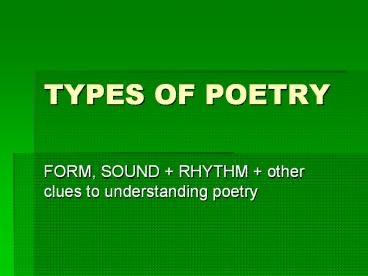TYPES OF POETRY PowerPoint PPT Presentation
1 / 17
Title: TYPES OF POETRY
1
TYPES OF POETRY
- FORM, SOUND RHYTHM other clues to
understanding poetry
2
FORM Narrative
- Tells a story
- May take the form of a ballad
- Generally organized in stanzas regular rhythm,
regular rhyme - http//judithpordon.tripod.com/poetry/robert_frost
_birches.html
3
Lyric
- Conveys strong emotions impressions
- Not necessarily set to music
- http//www.everypoet.com/archive/poetry/Rudyard_Ki
pling/kipling_if.htm
4
Blank verse
- Regular metrical pattern
- Does not have regular rhyme scheme
- Used frequently by Shakespeare
- http//www.types-of-poetry.org.uk/07-blank-verse.h
tm
5
Free-verse
- Very few restrictions
- No set rhyme, rhythm or line length
- http//www.types-of-poetry.org.uk/24-free-verse.ht
m
6
Sonnet
- 14 lines of iambic pentameter
- 2 main types-
- Petrarchan or Shakespearean
7
Petrarchan sonnets
- Also known as Italian
- Consists of an octave (eight lines w/regular
rhyme scheme), followed by a sestet (six lines
w/regular rhyme scheme) - Mood is set in the octave, then changed in the
sestet - abba, abba, cde,cde
- http//www.sonnets.org/basicforms.htm
8
Shakespearean Sonnet
- Three quatrains ( 4 line stanzas with regular
rhyme scheme), followed by rhyming couplet - Mood developed in quatrains, and changed in
couplet - Abab, cdcd, efef, gg
- http//www.cranberrydesigns.com/poetry/sonnet/exam
ples.htm
9
Dramatic Monologue
- Narrator reveals info about him/herself through
his/her own speech - Usually written in blank verese
- http//www.towerpoetry.ca/talk-DMonologue.html
10
Elegy
- A formal poem lamenting the death of an
individual or group of people - http//www.types-of-poetry.org.uk/elegy-written-in
-a-country-churchyard.htm
11
Epic
- A narrative poem that relates the mighty deeds or
adventures of heroes ina lofty, majestic style - http//listverse.com/2008/07/06/top-10-greatest-ep
ic-poems/
12
Haiku
- Three unrhymed lines
- Five syllables in the first line, seven syllables
in the second and five in the third - The final line resonates with more than one level
of meaning - Often about nature and passing of time
- http//www.international.ucla.edu/shenzhen/2002nct
a/cunningham/Webpage-HaikuPoems.htm
13
Concrete
- Arranged in a shape that enhances or reflects the
topic - http//www.google.ca/imgres?imgurlhttp//www.phil
obiblon.com/isitabook/literature/mouse1.gifimgref
urlhttp//www.philobiblon.com/isitabook/games/h
612w369sz115tbnidr3RiwhoJKQ__sMtbnh136tb
nw82prev/search3Fq3Dconcrete2Bpoetry2Bexamp
les26tbm3Disch26tbo3Duzoom1qconcretepoetr
yexamplesusg__toWKzEIkfGX_2AEChqc2sSOxNmAsaX
eiR0iiTdGpM8i-0QGq0-CIBQved0CCUQ9QEwAQ
14
SOUND
- Devices used to manipulate the meaning of the
words through sound - Alliteration,
- Assonance
- Cacophony
- Consonance
- Dialect
- Enjambment
- Euphony
- Repetition and refrain
- Rhyme
- http//www.poetry-online.org/poetry-terms.htm
15
RHYTHM
- The beat of the words and the lines even prose
lines have rhythm - METER comes form the combination of stressed and
unstressed syllables - (Da-vid)
- FOOT the variety of recognizable rhythm patterns
created by the particular combination of stressed
and unstressed syllables- ( youll get a handout
on this)
16
OTHER CLUES
- METRICAL VARIATION
- Short lines usually cause a person to read
SLLLLOOOOOOWWWWWLLLLYY - Therefore, you dwell on the idea, word, etc
- Long lines- read the line more quickly to make it
fit in the pattern of the rhythm used to give a
feeling of lightness, speed, vigorous activity or
urgency - Changing a foot pattern is used for emphasis
- Two or more stressed syllables in a line
emphasize the thought of each word and its
relation to others - Great irregularity in any one line usually
indicates strong emotions
17
OTHER CLUES
- LINE DIVISION
- Reasons for dividing lines or combining can vary
- To contain a complete thought
- To set off a strong image
- To emphasize a word or phrase
- To complete a thought started in a previous line
- To create irony or reverse an expectation

